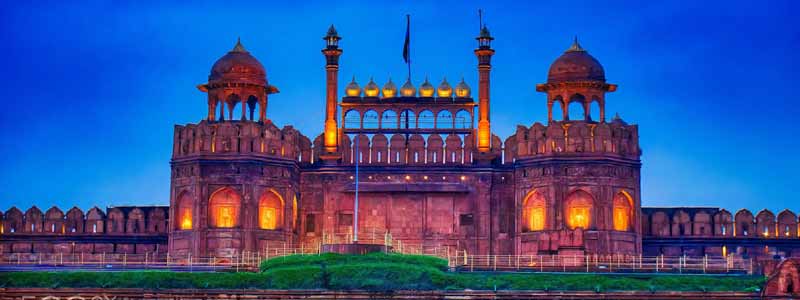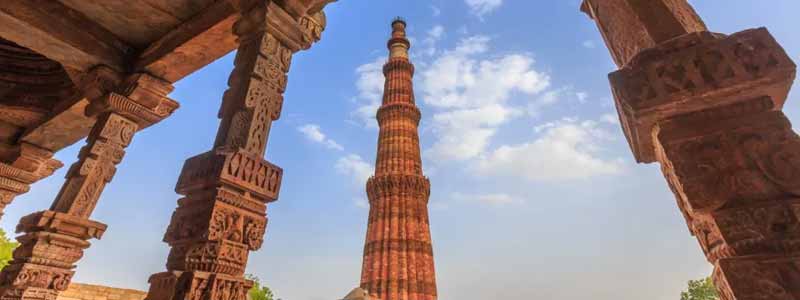Top 12 Best Tourist Places In Delhi, the capital of India, is a vibrant city blending history, culture, and modernity. Red Fort, a UNESCO World Heritage site, is an iconic Mughal-era fort with impressive architecture. India Gate, a war memorial, stands tall in central Delhi, offering a great evening ambiance. Qutub Minar, the world’s tallest brick minaret, showcases Indo-Islamic craftsmanship. The Lotus Temple is a serene Bahá’í House of Worship, while Humayun’s Tomb, a stunning Mughal monument, inspired the Taj Mahal.
For spirituality, visit Akshardham Temple, known for its grand design and cultural exhibitions, or the historic Jama Masjid in Old Delhi. Explore Chandni Chowk, a bustling market famous for street food and shopping. Raj Ghat, Mahatma Gandhi’s memorial, offers peace and reflection. Dilli Haat is a hub for handicrafts and regional cuisines. Jantar Mantar, an astronomical marvel, and Lodhi Garden, a scenic park with tombs, add to Delhi’s charm. These sites make Delhi a must-visit destination!

Red Fort
The Red Fort in Delhi, also known as Lal Qila, is a historic fort built by Mughal emperor Shah Jahan in 1648. It served as the main residence of Mughal emperors for nearly 200 years and is a UNESCO World Heritage Site.
The fort’s red sandstone walls stretch for 2 kilometers and reach up to 33 meters high. Its architecture is a blend of Persian, Timurid, and Indian styles. Key features include the Lahori Gate, the main entrance, and the Chhatta Chowk, a covered market. Inside are structures like the Diwan-i-Aam (Hall of Public Audience) and Diwan-i-Khas (Hall of Private Audience). The fort also has private apartments connected by the Nahr-i-Behisht, or “Stream of Paradise.”
The Red Fort is a symbol of India’s rich history and Mughal architecture. Every year on India’s Independence Day, the Prime Minister raises the national flag at the fort and addresses the nation.

Qutub Minar
The Qutub Minar, a UNESCO World Heritage Site in Delhi, India, stands as a towering testament to the early Islamic rule in the subcontinent. Its construction began in 1199 AD by Qutb-ud-din Aibak, the founder of the Delhi Sultanate, and was completed by his successors Iltutmish and Firoz Shah Tughlaq.
Standing at 72.5 meters, it is the tallest brick minaret in the world, showcasing Indo-Islamic architecture. The tower’s five distinct stories, adorned with intricate carvings and Quranic verses, taper upwards, displaying a blend of red sandstone and marble.
Originally intended as a victory tower and a minaret for the muezzin to call for prayers at the adjacent Quwwat-ul-Islam Mosque, the Qutub Minar complex also houses other historical structures like the Alai Darwaza, the Iron Pillar, and the tombs of Iltutmish and Alauddin Khalji.
Over the centuries, the minar has withstood natural calamities and undergone repairs, reflecting the architectural prowess of the Delhi Sultanate. Today, it remains a significant historical and cultural landmark, attracting visitors worldwide and symbolizing India’s rich heritage.
Humanyun’s Tomb
Humayun’s Tomb, located in Delhi, India, is a magnificent mausoleum built in 1570. It holds immense cultural significance as the first garden-tomb on the Indian subcontinent, inspiring major architectural innovations that culminated in the Taj Mahal.
Commissioned by Humayun’s first wife, Empress Bega Begum, the tomb was designed by Persian architect Mirak Mirza Ghiyas. It showcases a blend of Persian and Indian architectural styles, featuring a charbagh garden, a high terraced platform, and a marble-clad double dome.
Known as the “dormitory of the Mughals,” the tomb complex houses over 150 graves of Mughal family members. It stands near the shrine of the revered Sufi saint Hazrat Nizamuddin Auliya, adding to its spiritual significance.
In 1993, Humayun’s Tomb was declared a UNESCO World Heritage Site, recognizing its outstanding universal value. It continues to be a major attraction, drawing visitors to admire its architectural grandeur and historical importance.
India Gate
India Gate, a prominent war memorial in Delhi, is a 42-meter high sandstone archway, reminiscent of the Arc de Triomphe. It commemorates 70,000 Indian soldiers who died fighting for the British Army in World War I. Designed by Sir Edwin Lutyens, its foundation was laid in 1921, and it was inaugurated in 1931. The memorial bears inscriptions of over 13,000 British and Indian soldiers.
Following the 1971 Indo-Pakistan War, the Amar Jawan Jyoti, a flame for the unknown soldier, was added. Today, India Gate stands as a symbol of national pride and is a popular recreational area. The Republic Day parade passes by the gate annually.
Lotus Temple
The Lotus Temple, located in Delhi, India, is a Baháʼí House of Worship completed in 1986. Designed by Iranian architect Fariborz Sahba, its distinctive lotus flower shape symbolizes purity and unity, resonating across various cultures and religions. The temple’s construction, funded partly by Ardishír Rustampúr, took ten years and cost $10 million.
Composed of 27 marble-clad petals arranged in clusters of three, forming nine sides, the temple has nine entrances leading to a central hall. This hall, standing over 34 meters tall, can accommodate 2,500 people. The temple’s white marble exterior, sourced from Greece, is complemented by nine surrounding ponds, creating an illusion of a floating lotus.
The Lotus Temple is a significant example of modern architecture, blending Indian and Western styles. It has received numerous architectural awards and is a major attraction, drawing millions of visitors annually. This temple embodies the Baháʼí principle of the oneness of humanity, welcoming people of all faiths for worship and meditation.
Akshardham Temple
Akshardham Temple in Delhi, a sprawling complex dedicated to Swaminarayan, showcases 10,000 years of Indian culture. Opened in 2005, it’s a marvel of architecture built with pink sandstone and marble, following ancient Vastu Shastra principles. The temple complex houses a central monument adorned with intricate carvings, depicting scenes from Hindu mythology, Top 12 Best Tourist Places In Delhi.
Visitors can explore exhibitions on Indian culture and spirituality, enjoy a boat ride through India’s history, and witness a mesmerizing musical fountain show in the evening. The temple also offers a serene escape with its lush gardens and landscapes. Entry to the complex is free, but there are separate charges for exhibitions and the water show. It remains closed on Mondays and is open from 9:30 AM to 6:30 PM on all other days.
Jama Masjid
Jama Masjid, also known as the ‘Friday Mosque’, is one of the largest mosques in India, located in Delhi. Built by Mughal emperor Shah Jahan between 1644 and 1656, it stands proudly in Old Delhi as a magnificent example of Mughal architecture. The mosque’s courtyard can accommodate up to 25,000 worshippers.
Constructed with red sandstone and white marble, Jama Masjid features three grand gateways, four towers, and two towering minarets, each soaring to a height of 40 meters. The mosque’s original name was ‘Masjid-i-Jahan-Numa’, meaning ‘mosque commanding view of the world’.
Jama Masjid served as the royal mosque for Mughal emperors until the empire’s decline in 1857. It continues to be an important religious and cultural site, attracting devotees and tourists alike.
Chandni Chowk
Chandni Chowk, a bustling marketplace in Old Delhi, is a sensory overload of sights, sounds, and smells. This historic area, dating back to the 17th century, is a labyrinth of narrow lanes packed with vendors selling everything from spices and textiles to jewelry and electronics. The air is thick with the aroma of street food, a major draw for locals and tourists Top 12 Best Tourist Places In Delhi.
Chandni Chowk is not just a market; it’s an experience. The cacophony of bargaining vendors, the vibrant colors of the merchandise, and the sheer volume of people create an electrifying atmosphere. It’s a place where you can haggle for the best price, sample delicious local cuisine, and witness the vibrant energy of Delhi. Despite the chaos, Chandni Chowk holds a certain charm, offering a glimpse into the city’s rich history and culture.
Connaught Place
Connaught Place, also known as Rajiv Chowk, is a major commercial and financial hub in the heart of Delhi. Designed by Robert Tor Russell, its construction finished in 1933. Inspired by the Royal Crescent in Bath, England, it features Georgian architecture with colonnaded streets forming concentric circles.
Named after Prince Arthur, the Duke of Connaught, it was envisioned as a showpiece of Lutyens’ Delhi. Initially frequented by British officers and Indian royalty, it transformed into a bustling marketplace post-independence. Connaught Place houses numerous global chain stores, restaurants, bars, and historic cinemas like Regal Cinema. It’s also home to Palika Bazaar, an underground market.
Connaught Place is a significant tourist destination, offering a blend of colonial history, shopping, and nightlife, making it a vital part of Delhi’s cultural and commercial landscape.
National Museum
The National Museum in Delhi, established in 1949, is one of India’s largest and most significant cultural institutions. It houses an impressive collection of over 200,000 artifacts, encompassing a vast timeline from the pre-historic era to modern art. The museum’s diverse holdings include archaeological finds, sculptures, paintings, manuscripts, arms, armor, decorative arts, and anthropological objects.
Initiated with an exhibition of Indian art in London (1947-48), the overwhelming response led to the creation of a permanent National Museum. Housed initially in Rashtrapati Bhawan, its foundation stone was laid in 1955, and it opened to the public in 1960. The museum’s extensive collection offers a captivating journey through India’s rich cultural heritage, showcasing its artistic achievements and historical evolution over 5,000 years.
Raj Ghat
Raj Ghat is a memorial in Delhi dedicated to Mahatma Gandhi, the father of the nation. It marks the spot of his cremation on January 31, 1948, a day after his assassination. The memorial is a simple square platform made of black marble, inscribed with his last words, “Hey Ram.” An eternal flame burns at one end, symbolizing his enduring legacy.
Located on the banks of the Yamuna River, Raj Ghat is surrounded by lush gardens, creating a serene and peaceful atmosphere. The simplicity of the design reflects Gandhi’s own austere lifestyle. Visitors must remove their shoes as a sign of respect before entering the walled enclosure.
Raj Ghat is a significant place of remembrance, attracting dignitaries and people from all walks of life who come to pay homage to Mahatma Gandhi.
Hauz Khas Village
Hauz Khas Village, nestled in South Delhi, is a unique blend of historical charm and modern vibrancy. Its heart is the Hauz Khas Complex, featuring a medieval-era reservoir built by Alauddin Khilji in the 13th century. This “Royal Tank” (Hauz Khas) is surrounded by remnants of Islamic architecture, including a mosque and a tomb, offering a glimpse into Delhi’s rich past, Top 12 Best Tourist Places In Delhi.
In the 1980s, the village underwent a transformation, evolving into an upscale residential and commercial hub. Today, it’s a trendy spot known for its bustling nightlife, with numerous cafes, bars, and pubs. Art galleries and boutique stores add to its appeal, attracting a young and cosmopolitan crowd. The juxtaposition of ancient ruins and contemporary establishments creates a captivating atmosphere, making Hauz Khas Village a must-visit destination in Delhi.
